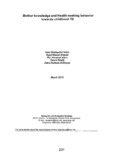| dc.contributor.author | Islam, Qazi Shafayetul | |
| dc.contributor.author | Ahmed, Syed Masud | |
| dc.contributor.author | Islam, Md. Akramul | |
| dc.contributor.author | Shatil, Tanvir | |
| dc.contributor.author | Siddique, Zakia Sultana | |
| dc.date.accessioned | 2019-12-04T09:21:16Z | |
| dc.date.available | 2019-12-04T09:21:16Z | |
| dc.date.issued | 2013-03 | |
| dc.identifier.citation | lslam, Q. S., Ahmed, S. M., lslam, M. A., Shatil, T., & Siddique, Z. S. (2013, March). Mother knowledge and health-seeking behavior towards childhood TB. Research Reports (2013): Health Studies, Vol - XLV, 200–222. | en_US |
| dc.identifier.uri | http://hdl.handle.net/10361/13194 | |
| dc.description.abstract | Introduction: BRAC in association with NTP recently started the community-based child
TB programme. So far, no independent study has been conducted to explore the extent to
which the objectives of the programme have been achieved in terms of raising knowledge
about child TB, and changing health-seeking behavior. This study uses quantitative method
to evaluate the knowledge, attitude and practices of mothers towards childhood TB.
Methods: The study was a cross-sectional in nature and it included mothers (257 in
numbers) as respondents on behalf of child TB patients. Structured and semi-structured
questionnaires were applied to elicit information. The study involved interviewing 157 BRAG
health workers (Shasthya Sebika. SS) to explore their knowledge regarding childhood TB.
Results: Both BRAG health workers (47%) and mothers (35%) did not have adequate
knowledge about the primary risk source for child TB (closeness of contact). The knowledge
of SSs (13-38%) and mothers (7-40%) regarding BCG and isoniazid therapy as a
preventive strategy of TB was inadequate and similar. Both the health workers and the
mothers had comprehensive knowledge about sputum test (67-78%) and X-ray (63-77%)
for detecting TB in children except about tuberculin test (27-28%). Clinical symptoms like
low grade fever (80-88%) and chronic cough (73-83%) were well known to them, but weight
loss was not noted profusely (20-54%). Majority of SSs (61 %) and the mothers (47%)
perceived that TB in children was dangerous. About half of SSs (50%) had high stigma.
One-fourth of mothers (27%) did not want to disclose their child's TB due to fear and 35%
of them became frustrated due to it. The time between the onset of symptoms and diagnosis
of TB among children was 60 days (mean). The majority of child TB patients were aged
between 11-14 years (46-65%) followed by 6-10 years (23-28%). More than one-third of
the children (38%) had exposure to TB patients at home, and 16% to neighborhood TB
patients. About 4 7% of mothers' children received treatment from informal providers at first
time. The providers commonly prescribed cough syrup (41%), tablet for fever (40%) and
antibiotics (37%). About 55% of mothers went to providers more than four times before
diagnosis of her child's TB. The majority of detected cases were diagnosed at district (23%)
and private hospitals (30%). A significant majority of children (85%) referred to BRAG for
treatment. Conclusion: Programme should organize special training on child TB for
awareness of health workers. Strong collaboration between NTP and local communities
are required to develop social mobilization, and sensitization in disseminating childhood TB
information. Healthcare providers need to set schedule to provide education, increase
awareness of contact case screening, early identifying and treating TB infection and
disease in children. | en_US |
| dc.language.iso | en | en_US |
| dc.publisher | BRAC Research and Evaluation Division (RED) | en_US |
| dc.subject | Health seeking behavior | en_US |
| dc.subject | Mother | en_US |
| dc.subject | Knowledge | en_US |
| dc.subject | Health workers | en_US |
| dc.subject | BRAC | en_US |
| dc.subject | Childhood TB | en_US |
| dc.subject.lcsh | Tuberculosis in children | |
| dc.subject.lcsh | Health, Nutrition, and Population Program (BRAC) | |
| dc.title | Mother knowledge and health-seeking behavior towards childhood TB | en_US |
| dc.type | Research report | en_US |

